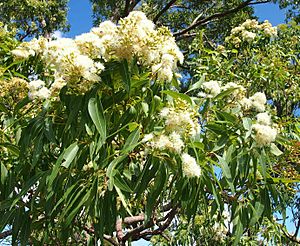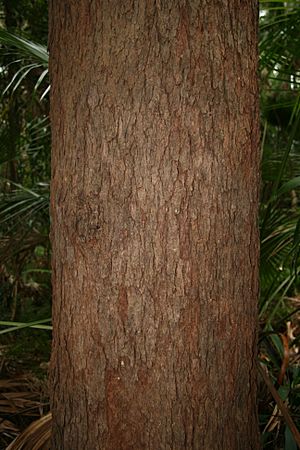Pink bloodwood facts for kids
Quick facts for kids Pink bloodwood |
|
|---|---|
 |
|
| Scientific classification | |
| Genus: |
Corymbia
|
| Species: |
intermedia
|
| Synonyms | |
|
|
The pink bloodwood (scientific name: Corymbia intermedia) is a medium to tall tree. It grows naturally only in north-eastern Australia. This tree is easy to spot because of its rough, checkered bark on its trunk and branches. It has groups of seven flower buds, which open into white flowers. Later, it grows fruit that looks like an oval or a small barrel.
Contents
What Does Pink Bloodwood Look Like?
The pink bloodwood is a tall tree. It can grow between 20 and 30 meters (about 65 to 100 feet) high. Its branches can spread out 10 to 20 meters (about 30 to 65 feet) wide. The bark is rough and looks like a puzzle, with many small blocks. It is usually light brown to grey. This special bark covers both the trunk and the branches.
Young pink bloodwood trees have long, narrow leaves. These leaves are dark green on top and lighter underneath. They are about 8 to 16 centimeters (3 to 6 inches) long. Adult leaves are also long and narrow, but they are a bit tougher. They are about 8 to 15 centimeters (3 to 6 inches) long.
Flowers and Fruit
The tree's flower buds grow in groups of seven at the ends of its branches. Each bud is shaped like a pear or an oval. They are about 7 to 10 millimeters long. The pink bloodwood usually flowers from December to March. Its white or cream-colored flowers are very fragrant and can be up to 20 millimeters (about 0.8 inches) wide.
After the flowers, the tree produces fruit. These fruits are hard capsules, shaped like an urn, oval, or barrel. They are about 10 to 20 millimeters (0.4 to 0.8 inches) long. The seeds are hidden inside these fruits.
The pink bloodwood looks similar to another tree called the red bloodwood. Both trees grow in central New South Wales. You can tell them apart because the red bloodwood has larger fruits and winged seeds.
Where Does Pink Bloodwood Grow?
The pink bloodwood tree is found along the eastern coast of Australia. Its range stretches from Gloucester in New South Wales all the way north to Cape York in Queensland. This is a huge area, about 2,500 kilometers (1,550 miles) long! It usually grows within 100 kilometers (60 miles) of the coastline.
This tree prefers soils that are loamy (a mix of sand, silt, and clay) or sandy. It can grow in places up to 1,200 meters (about 3,900 feet) high. It needs a good amount of rain, usually between 750 and 2,200 millimeters (30 to 87 inches) each year, mostly in summer.
Pink bloodwood trees often grow in open forests. Sometimes, you might find single trees in closed forests or at the edges of rainforests. It grows alongside other well-known Australian trees. These include the carbeen, forest red gum, blackbutt, and red mahogany.
Animals and Pink Bloodwood
The pink bloodwood tree is important for some Australian animals. In Bungawalbin National Park, a small mammal called the squirrel glider has been seen using these trees. Squirrel gliders bite into the bark to make a wound. Then, they lick the sap that comes out. The yellow-bellied glider also does this with pink bloodwood trees.
Scientists have studied how different gliders use forests. They found that where pink bloodwood trees grew, the sugar glider was often present. This shows how important certain trees are for different animal species.
Uses of Pink Bloodwood
The wood of the pink bloodwood tree is very strong and long-lasting. The inner wood, called heartwood, is dark pink to reddish-brown. People use this wood for building things like fences and bridges.
However, the sawdust from pink bloodwood can be irritating. It can bother your eyes and skin.
Sometimes, pink bloodwood is used in a special way for other trees. It can be used as a "rootstock." This means the roots and lower part of a pink bloodwood tree are used. Then, a different kind of tree, like the beautiful flowering Corymbia ficifolia, is joined onto it. This helps the grafted tree grow better.



